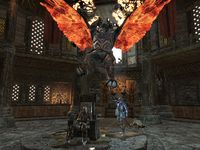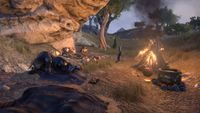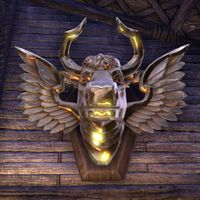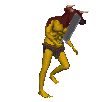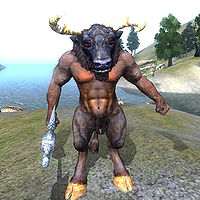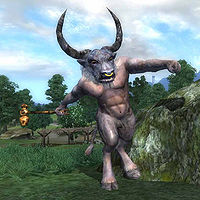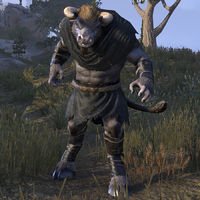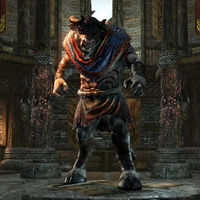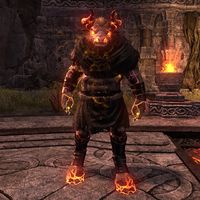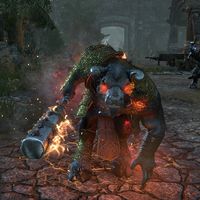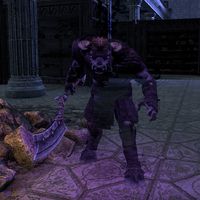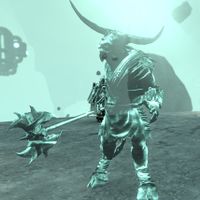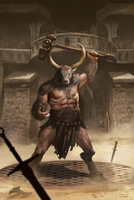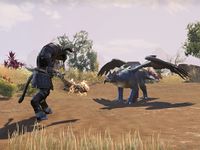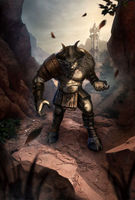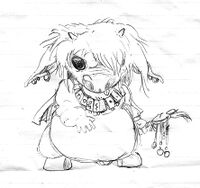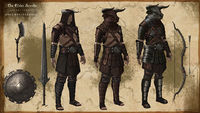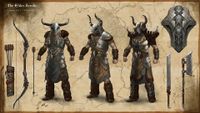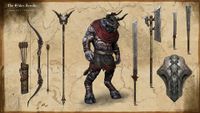Lore:Minotaur
Eternal guardians with hooves and horn.
What memories lead you to path there,
Is it Belharza or the Empire that you mourn?"
—The Minotaur Song
Minotaurs, also called man-bulls or bull-men, are a species of beastfolk native to Cyrodiil with the body of a man and the head of a bull. During the First Era, they were said to have symbolized the Alessian Empire, but in later eras became more commonly perceived as savage monsters by the people of Tamriel.[1][2]
They have thick grey or sometimes brown or red[3] hide and fur, and large curved horns. Some Minotaurs clothe themselves in a simple loincloth and shawl or wear nose-rings. Others wear intricate leather armor, and some prefer to be completely naked. They are most commonly found in the Blackwood,[3] Colovian Highlands, Great Forest and the Gold Coast regions of Cyrodiil,[4] as well as The Scar of Elsweyr,[5] the Reach,[6] and in ancient times across Bangkorai and Valenwood.[7][8]
Origins[edit]
- "We are ada, Mor, and change things through love. We must take care lest we beget more monsters on this earth. If you do not desist, she will take to you, and you will transform all Cyrod if you do this." —Pelinal on Morihaus and Alessia.
Although no records survive to confirm their origins, some scholars claim that Minotaurs trace their lineage back to the relationship between Empress Alessia and Morihaus. Their union gave birth to Belharza the Man-Bull, believed to be one of the first Minotaurs, who ruled the Empire after the death of Alessia.[9] This union being responsible for an entire race could be explained by Morihaus' nature as an Ada, who could "change things through love."[10] Conversely, other scholars dismiss such theories as both lightly heretical and having no basis in historical fact, instead claiming minotaurs to be the result of some magical accident or alchemical process, akin to a mantikora or vvardvark.[11] Regardless, in the years during and after Empress Alessia's reign, Minotaurs began to appear in greater and greater numbers. During this time, it's believed the early Minotaurs possessed intelligence and culture comparable to other races of beastfolk. Artwork and texts from the First Era suggest they were fiercely loyal to the Empire and were among Empress Alessia's most devoted defenders.[9][7] Some sources place Minotaurs on Tamriel before the First Era, and therefore before the union of Alessia and Morihaus.[8]
Despite their devotion to the Empire, Minotaurs were always a target of suspicion and fear because of their size and strength. With the rise of the fanatical Alessian Order, they were re-classified as 'monsters' no better than ogres or trolls and were driven into the forests, destroying whatever culture they previously possessed.[4] Much of the evidence to support this claim was also destroyed in the intervening period while the Alessian Order ruled the Empire. One remaining fragment of an ancient tablet depicts Alessian troops revolting against Emperor Belharza, giving some credence to the theory.[9] Minotaurs were not entirely wiped out by the Alessians, and continue to roam the backwoods and hills of Cyrodiil throughout the following eras.[4] By the Third Era, their noble ancestry was all but forgotten when some of them were rounded up and used as opponents for arena matches in the Imperial City.[12]
Behavior and Culture[edit]
Although excessively male as a species,[13] female minotaurs do exist. Minotaurs are social creatures, and often appear in groups numbering twenty or more. The largest male dominates this clan structure and has breeding rights with all females of reproductive age. Younger males will often challenge this dominant male in a fight to the death.[14][15] They have been observed to hoard gold and treasures at their camps for reasons unknown.[16]
Minotaurs are notoriously strong and difficult opponents in combat, despite their false reputation as clumsy brutes.[1] They are resistant to magic, can easily swing heavy weapons with one hand and their horns have the ability to tear through the toughest armor. The most powerful individuals are referred to as "Minotaur Lords".[12] They are believed by some to possess only rudimentary intelligence, but have a heightened sense of smell and can track a man by scent alone.[2] However, despite their supposedly rudimentary, they still seem to be able to produce complex works of metal and leather. Although Minotaurs commonly fight with weapons, some Minotaurs such as their shamans have the ability to use magic.[17]
One common observation of Minotaurs in the wild is that they tend to congregate around ancient ruins that were of significance to the Alessian Empire. Some believe they are drawn to guard these places on an instinctual level, possibly due to their ancestral connection to Morihaus, Belharza, or the Empire itself.[9][15][18][19] There are records of wizards placing hexes on Akaviri relics, drawing minotaurs in and around the tomb to guard it. "Yowling-powder" made from moon sugar, sulfur, lemon-peel, and daedra hearts can be used to break the enchantments on the relics, resulting in the minotaurs gradually leaving their post at the area.[20] Minotaurs also served as the protectors of the unicorn at Harcane Grove, which was killed in 3E 433 for the glory of Hircine.[12] The Elden Hollow beneath Elden Root was the final resting place for generations of minotaurs.[21]
Relationship with Other Races[edit]
Minotaurs share little civil interaction with humans or elves, but are typically free to settle around the ruins they inhabit. Minotaurs possess their own language, but few men understand their speech.[3] They mostly keep to themselves when unprovoked, but are also very territorial and will react aggressively on intruding adventurers. As a result, most inhabitants of Cyrodiil stick to well traveled roads to avoid contact with such creatures. Hearsay surrounding Minotaurs includes apples being poisonous to them, which results in travelers eating several before a journey.[22] Other examples characterize them as "cruel man-eaters", and they are sometimes used to scare children in tales and song.[2][23] Conversely, some children's toys are made to resemble Minotaurs.[24]
Reachfolk members of the Dreadhorn Clan were known allies of the Minotaurs.[25] At least some Reachfolk were capable of interpreting their language.[26] There were fringe cases of Minotaurs living alongside Khajiit,[27] Goblins,[28] and Maormer.[29] Some blacksmiths honor the Minotaurs by creating armor and weapons inspired by their characteristics, such as the use of horns in its design or Imperial iconography - appropriate for a race so deeply linked to the early history of Cyrodiil.[1]
Their severed heads are sometimes exported to other provinces, possibly to create wall-mounted decorations that were quite common in homes throughout Cyrodiil.[30][12] Minotaur meat was often used in the mid-Second Era to make slumgullion stew.[31] Oxblood fungal spores are known to grow on Minotaur, and are used by some blacksmiths in their work. Their horns are often displayed as prestigious hunting prizes or crafted into ornate warhorns and hunting horns.[32][33][34] Their horns are also valued by alchemists for their various alchemical properties.[12]
Notable Minotaurs[edit]
- Belharza: The first minotaur.[9]
- Bhrum and Koska: Twin minotaurs who ransacked an expedition[35]
- Domihaus: A colossal Minotaur warlord who allied with the Dreadhorn Clan in 2E 582 and attempted to take Falkreath.
- Galrus Grimhorn: A Minotaur that became a champion of the Hammerdeath Arena in High Rock some time before 2E 582.[36]
- Hruum the Red: A massive minotaur who killed Brumiun, Phalevon Vero's cousin[3]
- Khaath the Old:[3] Killed by Phalevon and had his remains fashioned into the Horn of Magnificence[37]
- Limenauruus: A colossal Minotaur encountered by the Dragonstar Caravan Company in 2E 582. He was discovered underground in the ruins of Fort Faleria, where Lord Nunex Faleria had enslaved and killed a large number of his kin centuries earlier.[38]
- Rahdgarak: The champion of Hunter's Grotto
Gallery[edit]
Appearances[edit]
Miscellaneous[edit]
-
A Gryphon and Minotaur face off (ESO)
See Also[edit]
- Minotaur Names
- For game-specific information, see the Arena, Oblivion, Elder Scrolls Online, and Legends articles.
Books[edit]
- On Minotaurs by Nonus Caprenius, Temporarily Unaffiliated Scholar of Imperial Antiquities — A historian's theory on Minotaurs
- The Last Battle of Phalevon Vero by Sirino Hentor, Elder Historian — The story of a Minotaur hunter's last battle
- The Minotaur Song — An ode to the Minotaur
- The Truth of Minotaurs by Tyronius Liore, Scholar of Imperial Antiquities — The dismissal of a theory surrounding the origin of Minotaurs
References[edit]
- ^ a b c Crafting Motif 39: Minotaur Style — Nonus Caprenius, Temporarily Unaffiliated Scholar of Imperial Antiquities
- ^ a b c Arena description
- ^ a b c d e The Last Battle of Phalevon Vero — Sirino Hentor, Elder Historian
- ^ a b c Lady Clarisse Laurent Answers Your Questions — Lady Clarisse Laurent and Stibbons
- ^ Events of ESO: Elsweyr
- ^ Appearances in ESO: Markarth
- ^ a b The Martyrdom of Saint Pelin — Priestess Adie Rodeau
- ^ a b Pocket Guide to the Empire, 3rd Edition: The Wilds Remain: Valenwood — Imperial Geographical Society, 3E 432
- ^ a b c d e On Minotaurs — Nonus Caprenius, Temporarily Unaffiliated Scholar of Imperial Antiquities
- ^ The Song of Pelinal, v 5
- ^ The Truth of Minotaurs — Tyronius Liore, Scholar of Imperial Antiquities
- ^ a b c d e Events of Oblivion
- ^ Hags, Harpies, and Hagravens — The Unveiled Azadiyeh, Songbird of Satakalaam
- ^ Brenus Astis' Journal — Brenus Astis
- ^ a b Solus Vertilus's Journal — Solus Vertilus
- ^ Minotaur camps in Blackwood and Gold Coast
- ^ Minotaur Shamans in ESO
- ^ The Minotaur Song
- ^ Britta Silanus' dialogue during Legend of the Man-Bull quest in ESO
- ^ Nisuzi's dialogue in ESO
- ^ Dialogue with Dracien Montue
- ^ Illia Polus' dialogue in ESO
- ^ A Gold Coast Children's Bestiary
- ^ Stuffed Minotaur Toy contraband item in ESO
- ^ Events of Falkreath's Demise in ESO
- ^ Reach Channeler's dialogue in ESO
- ^ Cud in ESO
- ^ Kinras Ironeye in ESO
- ^ Bloodwater in ESO
- ^ Aranecarne's dialogue in ESO
- ^ Minotaur Slumgullion food item in ESO
- ^ Pinarus' Prize Minotaur Horn in Oblivion
- ^ Minotaur Horn Warhorn contraband item in ESO
- ^ Aquilarios Crest Hunting Horn contraband item in ESO
- ^ Legend of the Man-Bull quest in ESO
- ^ Galrus Grimhorn character in ESO
- ^ Relics and Rumblings quest in ESO
- ^ Looming Shadows quest in ESO
|
|||||||||||||||||||||||||||||||||||||||||||

